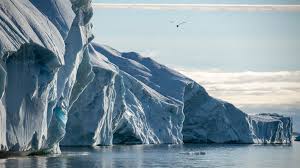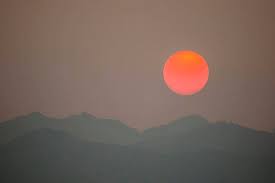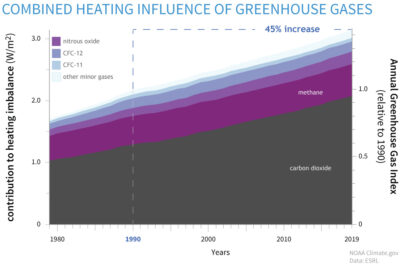The sun rose this Monday morning as it has for the past few days in an unnatural hue, an orange-red muddied at the edges by a haze that stretched from the peaks on all sides of the Arkansas River Valley, a smoky blanket that originated hundreds and thousands of miles away. The normally pristine peaks and clear blue sky were masked by the other-worldly colors of a planet that is changing.

Hundreds of wildfires are burning across the west, including in the normally cool and rainy Pacific Northwest. Image courtesy of Unsplash.
The culprit of this morning’s phenomena: wildfires here in the West have begun months earlier than the normal fall fire season; smaller fires in Routt County near Steamboat Springs, and massive fires further west and north: more than three-quarters of a million acres burning in northern California, Oregon, and Washington state, and more than 300 fires in normally cool and misty British Columbia. That high-level smoke is following the jet stream south and eastward.
The fires are but one sign of this reality: the planet is warming. The June just past was the warmest average temperature in North America since record-keeping began.
Greenhouse Gases are Rising
This spring, NASA scientists documented the highest levels of CO2 (carbon dioxide) recorded on this planet in the past 800,000 years (which they have tracked in polar glaciers). This is not simply ‘weather’; carbon dioxide, also referred to as greenhouse gases, is speeding up the planet’s increasing temperature; according to scientists from Scripps Institution of Oceanography and the National Oceanic and Atmospheric Administration (NOAA).
The rising CO2 is documented: global average atmospheric carbon dioxide in May 9, 2013, had CO2 levels in the air reaching the level of 400 parts per million (ppm for short), marking the first time in human history that this milestone was passed. By 2019 levels were at 409.8 parts per million, with a range of uncertainty of plus or minus 0.1 ppm. In the space of three years, with one of them a pandemic, earth’s carbon dioxide levels hit a 4.5 million-year high in May, climbing to 419 ppm.
The hurricane season in the North Atlantic began three weeks earlier than normal. By last week, NOAA reported that we have already reached “E” in the hurricane alphabet. Last year, we ran through the entire alphabet and began on Greek letters.
The western U.S., like large parts of Australia, is in the midst of a mega-drought (the southern hemisphere is in winter right now). The reservoirs necessary to life in most western states are at their lowest levels since they were first created. Crucial waterways, such as the Colorado River are over-allocated, even as the annual snowpack on the peaks of the Rocky Mountains that feeds them is diminishing.
Weather Extremes
It is not your imagination that average temperatures and extreme temperatures are increasing. The heat domes that have dropped on top of several regions of the U.S. are longer, more frequent, with more intense temperatures. Air temperatures and water temperatures in rivers and lakes are rising. In fact, just last week the hottest day on record in the West was recorded. But it was also the hottest temperature for that day on record for New Zealand and Hong Kong.
California crop farms reported that the fruit and vegetables that would normally be harvested now for America’s grocery stores have simply dried up on the vine. The heat domes that have repeatedly dropped on the Pacific Northwest are particularly cruel because this normally cool, rainy, and forested region is not equipped for temperatures that are surpassing 110 degrees; most homes have no air conditioning.
The extremes in temperature are growing. This past winter, normally mild Texas was hit with extreme cold. The Feb. 21 storm killed 15 people and caused $155 billion in damages. The state has yet to address the insulation of its power grid. But at the same time this past winter, the Great Lakes remained ice-free for months longer than normal.

Melting glaciers, and disappearing sea ice, leading to rising ocean levels, are symptoms of a warming planet.
North American storms no longer flow on a reliable jet stream. They wobble and stall over areas and dump violent weather, and torrential rains; a month or a year’s worth of rain in a single storm.
AVV readers have accessed our news stories about the melting glaciers, thinning sea ice at the poles, rising ocean levels, and ocean temperatures (follow this link to more than 50 stories about climate change).
Naysayers like to complain that it isn’t climate change, it’s just weather. Despite decades of research, too many U.S. politicians still deny climate change, a phenomenon so thoroughly documented as to find agreement among virtually every leading body of American scientists including NASA, NOAA, the National Academy of Sciences, the American Association for the Advancement of Science, the American Geophysical Union and the American Meteorological Society.
Yet, climate contrarians continue to reject the science and muddy the waters of public understanding. Some, such as a woman who submitted a comment on an Ark Valley Voice story over the weekend claim that initiatives such as Agenda 21, a voluntary, United Nations initiative that began in the early 1990s, are plots to destroy freedoms.
They are not. In the case of the 29-year-old Agenda 21 there are global efforts to ensure sustainability — in other words; an effort that can be worked on at the local, national and global level to ensure sustainable development, to prevent further destruction of the fragile balance of nature and human behavior. It was a product of the Earth Summit ( Conference on Environment and Development) held in Rio de Janeiro, Brazil, in 1992; an environmental action agenda that could be executed at local, national, and global levels.
The Paris Climate Accord is a global agreement to substantially reduce global greenhouse gas emissions in an effort to limit the global temperature increase in this century to 2 degrees Celsius above pre-industrial levels while pursuing the means to limit the increase to 1.5 degrees.
If you watched President Barack Obama’s 2016 State of the Union address, you might remember a frustrated nod to congressional climate change doubters. “Sixty years ago, when the Russians beat us into space, we did not deny Sputnik was up there,” said Obama. “We did not argue about the science or shrink our research and development budget. We built a space program almost overnight, and 12 years later we were walking on the moon.”
Resources to Track Climate Change
Five years ago, Live Science tracked five major facts about climate change. Not a single fact has changed; the timing has only accelerated.
This link shows how NASA is tracking climate change: https://climate.nasa.gov/earth-apps/
NASA’s “Earth Now” app displays real-time global satellite data of your planet’s vital signs. Great for students, teachers, and anyone interested in Earth science, this 3D app can be your go-to source for carbon dioxide conditions, gravity anomalies, ozone levels over Antarctica, and more. It’s free, decidedly dazzling and it puts the earth in the palm of your hands. Readers can download it to Apple or Android devices to keep their eye on the Earth.
For those with children, NASA’s latest educational game, Offset, can help them visualize the changes that could be made to slow the planet’s warming. It is part-pong, part-resource management, and 100 percent retro. The goal of the game is to slow the pace of global warming, and players learn about the global carbon cycle, different carbon sources, and ways alternative energy and reforestation can help offset those sources. The game requires quick fingers and strong multitasking skills!
Featured image: Smoky haze is adding an orange-red tinge to the rising sun. Photo courtesy of The Conversation.









Recent Comments